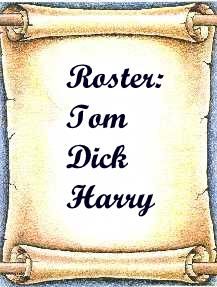Newsletter Story Submission Guidelines
by John Rich
This article will provide some guidelines for the best way to submit stories for publication in the HCC newsletter, "WaterLine". These guidelines are intended to ensure that the stories have the look that the author intends, and to minimize the workload of the sole newsletter editor.
Text:
| |
 |
 |
| |
doc files |
txt files |
The text of stories is preferred to be received in:
1) Word format, or; 2) text format.
Word is the common Microsoft word-processing software. The older version of Word saves the text in a file with a name ending in ".doc", and files from the new version of Word end in ".docx". I can accept and work with either version.
Text format can be as simple as an e-mail message, or a notepad file with the ".txt" suffix. I consider text files to be secondary to Word because they contain invisible line-breaks at the end of each line, like the carriage return on a typewriter, which messes up the vertical spacing. Those line-breaks have to be deleted to make the text flow properly for the web site html format.
Make your submission as short or as long as you like, anywhere from one paragraph to dozens. It doesn't have to be long and fancy, but if it is, that's great too. 
Please include the date or date range of the event, if applicable. If you're writing a generic article that isn't specific to a particular date, then this does not apply.
 Provide the first and last name of all participants, if you have them. Everyone likes to see their name in print and get recognition for their participation. And other club members are curious to keep up with who is paddling in what events. If it is an HCC club-sanctioned event, then the trip leader should have the complete list of names.
Provide the first and last name of all participants, if you have them. Everyone likes to see their name in print and get recognition for their participation. And other club members are curious to keep up with who is paddling in what events. If it is an HCC club-sanctioned event, then the trip leader should have the complete list of names.
It's nice to have details of the put-in and take-out locations, for reference by readers who might be contemplating duplicating your trip on their own.
Remember the old adage of the "five w's" of what is required for newspaper stories: who, what, where, when and why.
Photos:

|
| Photos |
The HCC web site software allows photos of a maximum size of 1,000 pixels in either the horizontal or vertical direction. So there is no point in submitting 5 megabyte photos that have enough resolution to wallpaper the inside of your living room. I realize that modern cameras with cheap and plentiful memory like to take them in that format, and you may want them that way for your personal use, and that's okay. But I ask that you please make copies of those mega-photos and downsize them to 1,000 pixels wide or high, before you send them to me by e-mail. If not, I just have to downsize the photos myself for the web site. 1,000 pixels provides good photo resolution for computer screen sizes.
If you don't know how to downsize photos, that's okay - get them to me any way you can and I'll deal with it. But if you do know how, do me a favor and downsize the photos before you send them. It will save modem transmission time, and reduce my workload. If you submit large photos, limit the e-mail photo submissions to about 10 megabytes each, and split them across multiple e-mails. It can sometimes be difficult for a very large e-mail to successfully complete transmission - the line always seems to get interrupted before the download finishes, and then it has to start all over again.
| |
 |
| |
Attachments |
| |
|
Submit your photos as attachments to an e-mail. I prefer that you not embed the images in a Word document. If you do embed them, I can still extract them, but once again, it requires extra work on my part to split the photos out of the document.
Indicate in your story text where you would like your photos to be placed. Do so by using the name of the photo file, so that I don't have to guess which photo belongs in what place. For example: "Now is the time (insert photo 'clock.jpg') for all good men to come to the aid of their neighbors." If you don't tell me explicitly, I'll have to guess at where they belong, which may not be the way you would like it. And then it would be more work again to go back in after-the-fact and relocate them. So just be explicit about photo location right up-front, to avoid any problems. And please be aware that formatting requirements may necessitate that I place photos in slightly different locations than you've specified. I need some leeway there, as two photos may try and overlap in the same space, and then they have to be separated.
If you have a large number of photos to put in your story, consider loading them into an album in the photo section of the web site, and the editor can insert a link from your story to the photo album. You can still place a few key photos directly in the text to enhance the story.
| |
 |
| |
Portrait
|
It's also nice to have a portrait of the author of each story, showing their face. I like to include those at the end of the story so that readers can recognize the person when they see them, and associate the name with the face. This helps us to get to know each other, and gives some recognition for those writers willing to spend the time to publish stories for the club. I've already built up a little file folder with such portrait photos of many of the regular contributors. If you're a new one, send me a face photo of yourself that you would like me to use. Of course, if you're shy, or on the FBI's "Most Wanted" list, this is not mandatory.
That's it!
Don't let any of these guidelines intimidate you and stop you from submitting a story if you've got one rattling around in your head trying to get out. If you don't know how to downsize photos, that's okay. If you don't know how to use Word, that's okay. If you're not very computer-literate, that's okay. Send 'em as-is anyway. I can deal with it. I would rather do more work and have your story, then to not have your story at all.
These guidelines are designed to present your story the way you want it to look, and to reduce the workload on the sole volunteer editor.
Thank you for your cooperation, keep those stories coming, and enjoy your newsletter! The more people that contribute, the more successful it will be.

|
John Rich,
Newsletter Editor
|